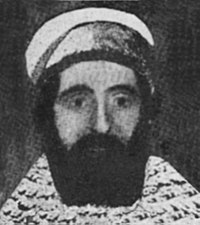This is an old revision of this page, as edited by PeleYoetz (talk | contribs) at 14:13, 13 May 2024. The present address (URL) is a permanent link to this revision, which may differ significantly from the current revision.
Revision as of 14:13, 13 May 2024 by PeleYoetz (talk | contribs)(diff) ← Previous revision | Latest revision (diff) | Newer revision → (diff)| Chaim Abraham Gagin | |
|---|---|
 image attributed to Chaim Abraham Gaguine image attributed to Chaim Abraham Gaguine | |
| Personal life | |
| Born | 1787 Constantinople, Ottoman Empire |
| Died | 23 May 1848(1848-05-23) (aged 60–61) Jerusalem, Ottoman Empire |
| Religious life | |
| Religion | Judaism |
| Jewish leader | |
| Predecessor | Yehuda Navon |
| Successor | Yitzhak Kovo |
Chaim Abraham Gagin (1787–1848) was Chief Rabbi of Ottoman Palestine from 1842 to 1848.
Born in Constantinople, he was the grandson of the Jerusalem Kabbalist Shalom Sharabi. Gagin was the first individual to hold both the positions of Hakham Bashi and Rishon Lezion simultaneously following their merger.
Regarded as one of the foremost poskim (Jewish legal decisors) of his era, Gagin also oversaw the Tiferet Yerushalaim Yeshiva. Among his notable works is Sepher Hatakanoth Vehaskamoth, a compendium of Jewish religious rites and customs as practiced in the City of Jerusalem. He was also the author of Chukei Chaim, a work addressing the debate on halukka, and Sefer Chaim MiYerushalaim, a collection of derashot.
In the years 1831-1840, the muslims in the Land of Israel were persecuting the Samaritans to either convert to islam or die, claiming that the Samaritans due to not being either Jewish or Christians were "idol worshippers" and therefore must be killed. The Samaritans asked Gagin to help them, and he wrote a document that the Samaritans are a "Jewish sect" to save them from extermination after many of them were forced to convert to islam.
Gagin was interred on the Mount of Olives.
References
- ^ ברטל, ישראל. "הארץ ויהודיה". In בן-נאה, ירון; הלד דילהרוזה, מיכל (eds.). הישוב הישן הספרדי בארץ ישראל (in Hebrew). מכון בן-צבי לחקר קהילות ישראל במזרח של יד בן-צבי והאוניברסיטה העברית. p. 15. ISSN 1565-0774.
- ^ "Chaim Abraham Gagin. Sepher Hatakanoth Vehaskamoth". Kestenbaum & Co. Archived from the original on 4 March 2016. Retrieved 9 August 2015.
- Westreich, Elimelech (2012). "Jewish Judicial Autonomy in Nineteenth Century Jerusalem: Background, Jurisdiction, Structure". Jewish Law Association Studies. 22: 303. ISSN 0890-7552.
- Isaac Ben-Zvi, "The Book of the Samaritans", 19353 Pp.36.
| Heads of Beit El Kabbalist yeshiva | |
|---|---|
|